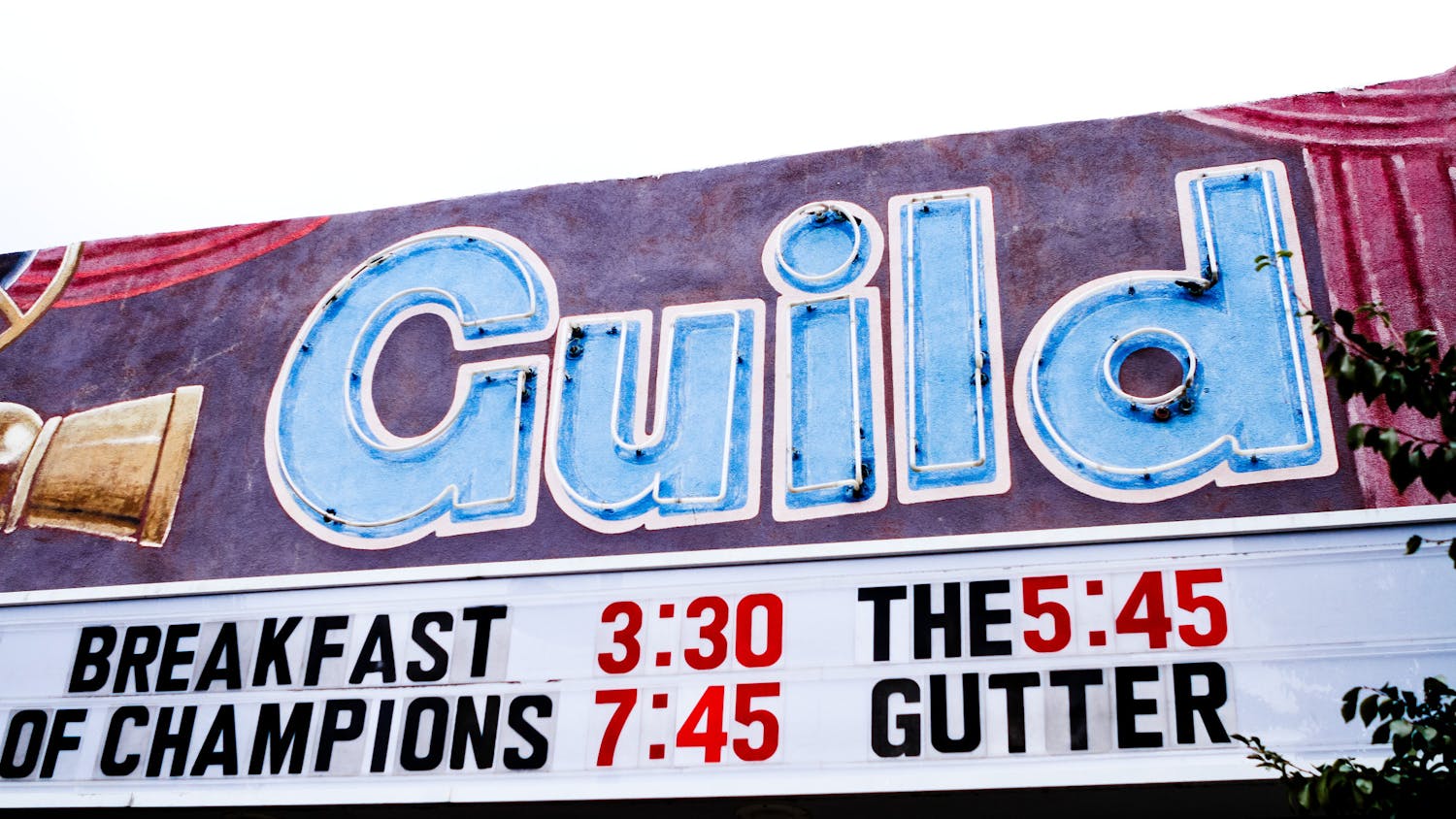When You See Light
The two TMG albums released in the middle of the decade, The Sunset Tree and Get Lonely, are as notable, but in a different way. There might be a greater stylistic difference between each of the three previous records—first recording in a studio, then embracing a full band—but the transition between WSABH and The Sunset Tree is perhaps just as jarring. Both center around autobiography, but the first is a character sketchbook cloaked in the language of verisimilitude. The two albums that follow are clear as day, and dark as what comes after clarity.
Talking to Marc Maron on the WTF podcast, Darnielle observed that “in many ways [The Sunset Tree is] the first Mountain Goats album … it’s like, all this stuff before that, sort of feels like a study for when I was able to tap something.” He started writing it soon, and quickly, after the death of his abusive stepfather, and the immediacy comes through in the music. Though the opening triptych of songs mirrors that of Tallahassee — introduction, opening scene, action — the tight construction of that album soon gives way to various tableaux about or based on Darnielle’s life under his stepfather, chosen less for narrative fluidity than resonance. The arrangements are less dense, and the instrumentation shimmers, through songs that are direct and sometimes anthemic. One such song, “This Year,” recalls a day that leads up to terror, and culminates in a popular line, “I am gonna make it through this year, if it kills me,” that takes the paradox of feeling and runs it through a state of urgency. Another, “Up The Wolves,” is sung from out of scene, in metaphor; the whole album fluctuates between those sets of approaches. If it ends up lacking the surface cohesion of its predecessors, one gets the feeling that anything that gets the signal across is necessary. In the WTF interview, Darnielle recalled teenage abuse victims contacting him after the album’s release, telling him it was useful to them.
If that album is a vehicle for reflecting across boundaries of communication, the next one, Get Lonely takes its shimmer and turns it inward. It’s quiet and low-key, “a root-fire of a record,” according to Scott Solter, the record’s producer. The songs aren’t bound by character so much as a similar emotional space, which often runs into the physical kind: “[I will] look up at the high windows / and see your face up there”; “I was happy till the overnight attendant / switched on the floodlight.” There are instrumental flourishes, but the visible core is Darnielle and his acoustic guitar, which might bring to mind his earlier recordings. Here, though, he mostly sings close to a whisper, and the songs deal less with anticipation than aftermath; where the landscape was once an indication of what’s to come, here it’s merely something to live through, but no less a presence—“and the world, in its cold way, started coming alive.” The record has the melancholy sprawl of AHWT, the single voice (and, at times, anxious pull) of Tallahassee, but also the personal embrace of a “confessional” work. Which, if you’re in a certain headspace, makes it an easy album to get lost in, and perhaps easy to miss its stark, albeit almost comforting conclusion.
Around the release of The Sunset Tree, Sasha Frere-Jones of The New Yorker touted Darnielle as “America’s best non-hip-hop lyricist.” It’s a high accolade, but one that was given during a time when The Mountain Goats qua literary project, as was its original intent, seemed to shed. That shift allowed for new opportunities, but there’s a reason why some look at the mid-2000s as a cut-off point in quality. If most include The Sunset Tree in the first half, it’s also where marks of later Mountain Goats work first appear: the directness, odes to survival, references to real people, slipping freely in and out of diegesis, and, really, a bit of age in the voice. Work after the study.
Transcend, Just Stay Alive
If The Sunset Tree and Get Lonely were the start of something, they also constituted their own period, one focused less on character sketches than outward projection, or at least the appearance of it. For 2008’s Heretic Pride, Jon Wurster of Superchunk was recruited on drums, a position he’s held since. Each album from that point onwards has some unifying theme, be it a specific subject, like wrestlers and goths on their most recent releases, or a looser outline: navigating a world of evil, wherever it comes from (Heretic Pride); dealing with ghosts, in whatever way they’re haunting (All Eternals Deck); compromising with your illnesses to last a little longer, and maybe feel a little better in the process (Transcendental Youth). Clouded with fog, cloaked in fantasy, cornered by the ring, cut off by the walls of your house: these limits function the way states and nations once did. There’s the fundamental difference—you can boil the latter down to, and build up from, abstractions.
The lyrical expansion comes hand in hand with that of the music. Though the first few studio albums had a noticeable amount of variation between them, they tended to either be low-key or subsumed in the narrative. On almost everything after there is a distinctive touch to it that sounds like the band pushing itself in a different direction. Not to say that they aren’t made to fit the lyrical content, per se—the strings, wailing and pizzicato, on Heretic Pride conjure the roiling forecast on the cover; and the space and theatrical flourishes (like the a cappella backing on “High Hawk Season”) of All Eternals Deck evoke a nocturnal fantasy that’s become warped, dangerous and comforting at different points. The horns on Transcendental Youth aim high and heralding, where on Beat the Champ they’re as dry as everything else. But where the first few studio albums seem submerged in their own narratives, these records’ sonic identity sticks out in comparison.
A partial outlier in these respects is 2009’s spare The Life of the World to Come, which consists of “twelve hard lessons the Bible taught me, kind of.” At this point Darnielle was a lapsed Catholic who had been referencing the Bible plenty, so this wasn’t new territory, per se. As an album-length restriction, though, it opened up new textual resonance, be it irony that’s not quite irony (in “Psalms 40:2,” the one aggressive track here, a church arsonist looks for salvation in degradation); application in a world removed from its intention, physically and temporally; and interpretations more oblique, ones that, as such distances do, force the listener to consider the connection. It also spares room for “Matthew 25:21,” one of his longest (5:50) and most personal songs, which deals with his stepmother’s death. The album came out of a personally exposed time, as The Sunset Tree did, and though its aims are broader it shares that album’s sense of intimacy.
Theological symbols, destinations, aspirations—these are really just more objects of remove, another form of distance for the songs’ inhabitants. The scope is just a bit broader now, a change that started with The Coroner’s Gambit and continued as the songs grew to accommodate it. “I am this great, unstable mass of blood and foam / and no one in her right mind would make my heart her home,” the chorus refrain in “Autoclave,” could easily fit after “I am a land mine hidden in the sand.” But Darnielle seems to be having a bit more fun this time around; here the last verse details a dream in which the narrator is “perched atop a throne of human skulls,” a gothic landscape filled with causality and empty of consequence. It ends with the justification that “sometimes you wanna go where everybody knows your name.” The dream: got thou, mine Satan.
Get content from The Daily Lobo delivered to your inbox
The Unholy One has been referenced explicitly a few times before in the Mountain Goats discography, not a whole lot, but the cast of a darkness larger than oneself is a common framing device. The new album, Goths, uses a subculture submerged in it to familiar ends, but in a way its aesthetic signification frees it up to be a little lighter, and freer, than past records. In one song a character sings about killing the softer creature in him, but the chorus boast, “but I have high unicorn tolerance,” dissolves over a bouncy rhythm section that includes a flute and sax. It betrays a grey area between necessity and unwillingness, and one that doesn’t take itself too seriously. The record has no guitars, which would have been unfathomable a couple decades before, and the narrative lens, wide enough to accommodate referencing classic rock stations and Wikipedia pages, is just as different.
The voice, though, is at root the same: one of an outsider looking in, perhaps like Satan himself, forced to compromise with the fact, at least for the moment. The variety of the Mountain Goats catalog is in what’s on the other side—a person, past; recognition, recovery; escape, home. There may be a chance of getting across, or maybe not, but there’s at least someone to speak for it in the moment of uncertainty, of dread. Goths ends with the acknowledgment of a band’s “suffocated splendor,” which the only kind of splendor there seems to be in their songs. In continually singing of it, though, it becomes just a bit less suffocated. That’s why their songs in particular lend themselves to repeated listens: eventually something will rise, be it like lithops or salmon at the spawning, and be heard.
More Grim Particulars
I’d be remiss not to mention the various releases, official or otherwise, and bootlegs not covered in that survey. On Spotify, you can find three EPs, two lo-fi and two hi-fi: Beautiful Rat Sunset, Nine Black Poppies, Babylon Springs, Dilaudid. The second has a song that was particularly touted when during the Chicago Cubs’ World Series run; the first has the only TMG song I know of about a lost dog. There are other EPs not streaming, mostly from the 2000s, including collaborations with Kaki King and John Vanderslice, the latter of whom has produced several of the band’s LPs.
The last of those four EPs is really just a single, and there are a few of those as well, but that one is notable for having “Collapsing Stars,” which you can find an alternate (more popular) version of on Come, Come to the Sunset Tree, a demo LP for The Sunset Tree with alternate versions of songs on the album and outtakes. Demo LPs in the same vein were also released for The Life of the World to Come and All Eternals Deck. The first, just Darnielle and his guitar, is particularly instructive in showing how much his songwriting had changed in just a few years.
There are also a couple of unofficial releases: the Jack & Faye EP and Hail and Farewell, Gothenburg. The former was intended to be released in 1996 but, after complications, was only leaked later. The latter, though, was originally meant to be the follow-up to Sweden but was eventually shelved; its leak more than a decade later was against John’s wishes. (He’s since taken a hardline stance on destroying anything he wants unreleased.) If you want to hear it, it’s worth knowing that the album was mastered half a pitch above performance.
And then there are various songs that have only been performed live, completely unreleased. One could go on listing all the songs out there, but the fun of being a huge fan of anything is searching the crevices. I certainly haven’t heard everything, and it’s a cool thing to keep finding new songs, versions, performances to dig into. So I’ll leave it at this.
(Or, one more thing: Darnielle’s band with Franklin Bruno, The Extra Lens, f.k.a. The Extra Glenns, is also worth checking out.)
Got It, Satan
So I hope that’s all informative and helpful, especially when you’re listening, but the question still remains, in what order?
The most common advice seems to be to start with All Hail West Texas and Tallahassee and work backwards or forwards depending on which is preferred (or both simultaneously). Which is understandable, and for reasons relating to a line near the end of each, those two albums should be listened consecutively, in order, but AHWT isn’t really representative of most of the Mountain Goats’ lo-fi work, nor is The Coroner’s Gambit, for reasons explained above. So if you decide to work backwards through those and Full Force Galesburg, that’s something to keep in mind. I’d also recommend hitting up at least one of the comps past that point before getting to the other albums—Bitter Melon Farm is my favorite, but they’re all good surveys.
In terms of hi-fi TMG, working forward also works, but after Tallahassee I would probably recommend going:
We Shall All Be Healed → Get Lonely → The Sunset Tree.
The first two have very cohesive aesthetics, and provide a good amount of contrast both in storytelling and sound. And like I’ve said, the transition from WSABH to The Sunset Tree is a bit jarring, so I think having Get Lonely as a preface of sorts could make it easier to appreciate for what it is, rather than what it’s not. But if you need to hear a record like it, put it before all the others.
From there—well, everyone has their favorites. If you end up hooked, you’ll find your own. If you don’t want to dive into albums right away, this is a good playlist (courtesy of Jess Harvell) from which to sample. There’s probably something in there for you. If you can get past the voice.
Eric Ng is a contributor to Daily Lobo Music. He can be reached at music@dailylobo.com






